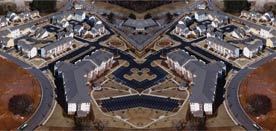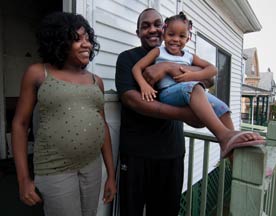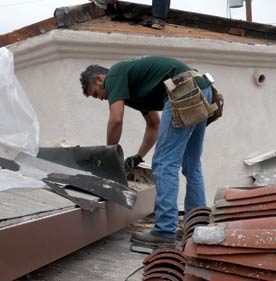
Photo courtesy of Invest Atlanta
A year ago, the Beach Street corridor of Flint, Michigan, was pockmarked with 16 trash-filled vacant lots. Today, this 2-acre area a mile south of downtown Flint has been consolidated into Flint River Farm, the city’s largest urban farm, replete with a passive solar hoop house for year-round growing, in what had previously been a blighted stretch of food desert. The two women who farm this land own three of the lots and lease the others from the Genesee County Land Bank.
Neighbors have welcomed the endeavor — for its beauty, for the valuable food choices it offers the community, for the job prospects it has created, and for lending hope to residents who are toughing it out in one of the nation’s most famous Rust Belt cities.
In the decade since Genesee County first took steps to create its nonprofit land bank, a growing number of municipalities, counties, and states have begun to embrace land banks as a tool to systematically address vacant and abandoned properties. A land bank is an entity, public or nonprofit, with the authority to acquire vacant or distressed property, clear title and taxes, and assemble it, redeploy it, or maintain it in strategic ways, rather than based on the short-term highest bid.
Land banks offer public agencies a number of robust options to undercut dynamics in the real estate market that often foment, rather than avert, urban blight. This can deliver real benefits, even in what are arguably the most challenging housing and economic environments this nation has confronted in decades. Properties that are too deteriorated, low-value, or constrained by title problems to be feasibly preserved or rehabbed either by the market, partnerships, or even subsidized nonprofit programs can often be turned into assets, or at least less actively negative influences, by the intervention of a land bank.
Interrupting Speculation
Typically, abandoned properties are forced upon the open market through tax foreclosure sales, where speculators concerned with quick profits rather than long-term community viability flip them or simply let them lie fallow. Local authorities have little say in how these properties are repurposed, leaving significant percentages unoccupied, unused, and forgotten. County treasurers are typically legally compelled to put these properties’ tax liens up for sale. Where clear title to abandoned properties does not exist — often the case with tax-sale properties — public officials find their hands tied when trying to move properties back into productive use. And yet, taxpayers and their public agencies continue to shoulder the financial and social costs of these blighted properties — crime, deterioration, falling property values, and a foundering tax base.
Land banks change this dynamic. Frank Alexander has described the options that land banks offer as a “deep breath” for communities working to decide the fate of tax-foreclosed property. They have the legal authority to efficiently acquire, hold, manage, and develop tax-foreclosed property. They can clear liens and title problems. They can systematically assemble multiple lots and properties for productive reuse, where before a developer might have struggled to stitch together multiple parcels of land to construct senior housing or commercial space, or local governments may have strained to assemble multiple lots for a new school or parkland. Land banks can sell properties on the open market, or to targeted purchasers such as adjacent homeowners or nonprofits. They can hold other properties off the market until the time is right, renting them out or demolishing structures and greening lots to reduce harmful effects in the meantime.
With these powers, land banks give local governments the capacity to have some say in the path that development and reuse takes and think about redevelopment efforts beyond a single property, at the level of a block, a neighborhood, and a region.
Above all else, public land banks democratize development decisions, giving local residents and the business community the capacity to have a say in ensuring that blighted property is not just identified and regulated, but responsibly remediated to the greater good of the community. Where before, neighborhoods struggled with the consequences of neglected properties, land banks allow cities and counties to take responsibility not just for the economic consequences of blighted land, but for the process of ensuring that this land is put in the hands of those committed to responsibly redeveloping that property.
While land banks are most commonly associated with older urban areas struggling with systemic disinvestment, virtually any community can benefit by using this tool. That includes healthy communities seeking to deter deterioration, and smaller communities seeking to prevent land from sliding into inexorable decline.
All land banks are not created equal, however. Successful land bank programs rely on four critical elements:
- a connection to the tax foreclosure process in the community as an alternative to the auction process;
- formation around the largest, most diverse market possible, typically at the county or regional level;
- decisions that result in transparent, accessible documentation; and
- a commitment to be engaged with the community and to encourage ongoing interaction with residents.
Last year, the Center for Community Progress, whose mission is to support communities in creating solutions for problem properties, helped New York State craft legislation using these criteria allowing for the establishment of nonprofit land banks in 10 target areas, which Gov. Andrew Cuomo signed in July. This initiative is particularly important in western and upstate New York, where the volume of vacant and abandoned properties is simply too overwhelming to be absorbed into the current real estate market using conventionally available mechanisms.
The Flint Model
New York’s decision to deploy land bank legislation was based on proven track records in other parts of the nation.
Flint pioneered the modern version of the public land bank in 2002. While Flint still confronts the challenges that stem from the flight of heavy industry from the region, land bank intervention caused surrounding property values to be restored by over $100 million, according to a 2007 study by Nigel Griswold and Patricia Norris of the MSU Land Policy Institute.
As a first step in formally launching the Genesee County Land Bank, elected officials first had to introduce legislation that reformed the state’s obsolete foreclosure system, establishing a direct connection between foreclosed properties and the land bank, which became the primary mechanism for managing and repurposing thousands of properties.
Then, the land bank and county government created a self-financing mechanism, in which the county treasurer’s office issues short-term bonds to fund unpaid taxes, then collects the taxes to repay the bonds, effectively acting as a benevolent tax lien purchaser. That critical step ensured that vacant, abandoned properties no longer posed an investment opportunity for speculative investors, and the county was able to earn a return on its investment that could be distributed back into rebuilding its tax base.
Before reform, Michigan’s tax foreclosure process left tax-reverted properties hopelessly mired in a legal limbo, contributing to urban decline in places like Flint by keeping properties off of the tax rolls and out of circulation for up to seven years. Today, the county treasurers can take outright ownership of vacant and abandoned property after only two and a half years, significantly enhancing efforts to remove dilapidated structures, redevelop abandoned properties, and restore communities’ economic base.
Genesee County understood that development cannot necessarily be simply left to its own devices, particularly when a city and a region are confronting systemic dynamics like deindustrialization. In practical terms in Flint, that has meant using the land bank as a mechanism to demolish more than 1,200 blighted properties and sell thousands of othersÐreturning millions of dollars to the property rolls. It gave Flint the power to create hundreds of units of affordable housing through sales and rentals to carefully selected buyers. While challenges still abound, the data clearly shows that the land bank has played a critical role in helping to stabilize neighborhoods, deter blight, and give local residents not just hope but real practical gains to point to in buttressing their blocks from the consequences of unfettered decay.
Embracing the Land Bank Model
The Genesee County Land Bank has become a model for other programs in Michigan and across the country. Today, 37 land banks operate in Michigan, just under half of the land banks in the United States. Pennsylvania is currently considering land bank legislation. Michigan, Missouri, Ohio, Kentucky, and Georgia all have specific legislation authorizing public land banks, and about a dozen other states have development authority statutes or similar mechanisms in place that can function to some degree as land banks.
One exciting example is the Cuyahoga County Land Bank, covering the Cleveland metro area, which has been in place since 2009. In the last two years, the land bank has acquired more than 1,200 abandoned properties and crafted groundbreaking partnerships with HUD, Fannie Mae, and leading banks to take vacant land out of the downward spiral of speculation, blight and disinvestment by having low-value, obsolete properties not remain on the market or in REO status, but transferred to the land bank, with a donation to cover demolition costs. (See “(Land) Bank of America?” SF Fall 2011.) Those relationships have begun to have a profound effect in slowing the volume of what the land bank describes as “speculative trafficking in low-value, abandoned properties in Cuyahoga County.”
Cuyahoga County modeled its land bank on Genesee County’s innovations, integrating sweeping reforms in the tax foreclosure process within a leverageable funding stream, and operating an efficient, data-driven nonprofit endeavor that brings formidable transactional capabilities to bear across whole blocks and neighborhoods. The land bank funds its operations each year with roughly $6 to $7 million dollars it collects in penalties and fees from delinquent property tax bills — dollars that previously would have gone into the coffers of tax-sale speculators, including many of the banks at the heart of the foreclosure crisis and the subsequent federal banking bailout.
That’s allowed the region to bring scale to revitalization efforts and capitalize on the urban area’s substantial institutional assets, from Cleveland’s revitalized warehouse district and extensive network of nature trails to Playhouse Square — a performing arts complex second in size only to Lincoln Center — and the Cleveland Clinic, which is advancing some of the most cutting-edge medical research and treatment protocols in the nation. The Cuyahoga Land Bank has helped leverage responsible reuse across the region and supports the ongoing dynamism of these vital institutions.
In Kalamazoo, Mich., local officials have used their county land bank (created in 2009) for blight removal and corridor redevelopment, to foster new construction of commercial areas, to support community garden and beautification programs, and to assemble and reposition property across the city. That includes the acquisition last year of 56 tax-foreclosed properties through NSP II — the second phase of the federal Neighborhood Stabilization Program — slated for demolition, rehabilitation, or set-asides for property assembly for future development projects.
Land banks aren’t limited to acquiring tax foreclosures. The Kalamazoo County Land Bank, has also entered into purchase agreements on bank-foreclosed properties near other targeted investments, allowing the city to craft a block-by-block approach that maximizes the strategic impact of its redevelopment efforts.
What’s more, its strategies drill down to the hyperlocal level where individual homeowners and renters realize real gains, illustrated in the recent implementation of a side-lot and garden program that has been enthusiastically welcomed by local community partners and residents. At the same time, the land bank facilitates interventions that have effects well beyond a single problem property, encouraging a reclamation and reuse strategy that is more comprehensive, and ultimately more effective as a tool for stabilization and revitalization across whole neighborhoods.
The Community Role of Land Banks
For land banks to maximize their positive impact, it is critical for them to earn the trust of residents in distressed communities, who are often suspicious of government’s role in managing blight or being involved in real estate at all. Land bank authorities can earn the trust of community members and increase the level of community participation in the redevelopment process by providing responsible oversight and a commitment to transparency.
Residents of local communities and the business endeavors that employ them share a commitment to the long-term viability of their neighborhoods and the larger region. When these core constituencies — residents, the local business community, nonprofit partners, and engaged developers — come to see land banks as partners in responsible, comprehensive redevelopment goals, land banks can bring real scale and long-term benefits to distressed neighborhoods and communities seeking a path forward to long-term economic and social well-being.




Comments